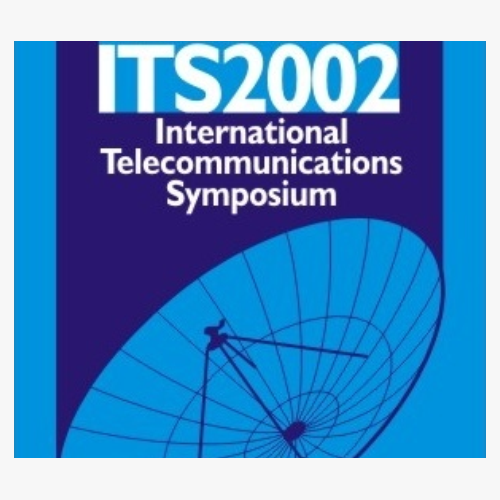
2002 International Telecommunications Symposium

An ATM Switch with Distributed Cell Scheduling
M. P. C. Arantes, S. Motoyama
DOI: 10.14209/its.2002.162
Keywords:
Abstract
"An ATM switch with distributed cell scheduling is proposed in this paper. By using a crossbar switching structure with large buffers at input ports and small buffers at each crosspoint, the cell scheduling is distributed at input and at crosspoint buffers. The discrimination of incoming cells into service classes at input buffers, and the use of a modified virtual output queuing (VOQ) technique provide, to the proposed switch, facility to satisfy easily the QoS and a throughput of 100%. An example of performance analysis based on priority service classes is carried out and the results show a very promising ATM switch."Download

Simulation Study of CAC Algorithms for ATM Networks
Niudomar Siqueira de A. Chaves, Shusaburo Motoyama
DOI: 10.14209/its.2002.168
Keywords:
Abstract
"In this paper a performance study of three CAC (Connection Admission Control) algorithms for ATM networks is presented. The results are obtained through discrete event simulation. Two of the algorithms are based on effective bandwidth concept and the other is a measurement-based method, which uses the actual traffic besides the formal parameters. The analysis showed that all the algorithms achieve the required QoS, however they overestimate the necessary bandwidth in several situations, resulting in lower network resource utilization."Download
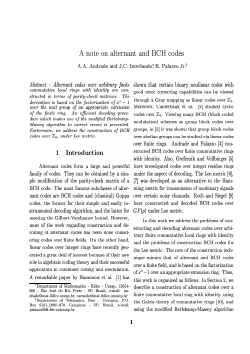
A note on alternant and BCH codes
A.A. Andrade, J.C. Interlando, R. Palazzo Jr.
DOI: 10.14209/its.2002.174
Keywords:
Abstract
"Alternant codes over arbitrary finite commutative local rings with identity are con- structed in terms of parity-check matrices. The derivation is based on the factorization of x\u00b0 \u20141 over the unit group of an appropriate extension of the finite ring. An efficient decoding proce- dure which makes use of the modified Berlekamp- Massey algorithm to correct errors is presented. Furtermore, we address the construction of BCH codes over Zy, under Lee metric."Download
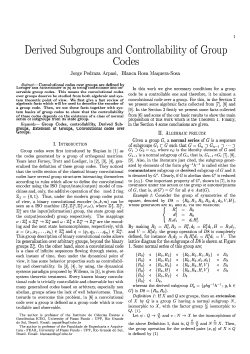
Derived Subgroups and Controllability of Group Codes
Jorge Pedraza Arpasi, Blanca Rosa Maquera-Sosa
DOI: 10.14209/its.2002.180
Keywords: Group Codes controllability Derived Sub- groups Extension of Groups Convolutional codes over Groups
Abstract
"Convolutional codes over groups are defined by Loeliger and Mittelholzer in [6] as being controllable and observable group codes. This means the convolutional codes over groups deserve be studied from both algebraic and system theoretic point of view. We first give a fast review of algebraic facts which will be used to describe the encoder of a group code. Then, we use these facts together with system basics of group codes to show that the controllability of these codes depends on the existence of a class of normal series of subgroups from its state group."Download
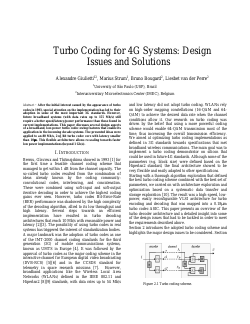
Turbo Coding for 4G Systems: Design Issues and Solutions
Alexandre Giulietti, Marius Strum, Bruno Bougard, Liesbet van der Perre
DOI: 10.14209/its.2002.184
Keywords:
Abstract
"After the initial interest caused by the appearance of turbo codes in 1993, special attention on the implementation has led to their adoption in some of the most important 3G standards. However, future broadband systems (with data rates up to 155 Mb/s) still require a better speed/latency/power performance than those found in current implementations. This paper discusses several design aspects of a broadband, low-power turbo codec owing features that enable its application in the incoming decade systems. The presented ideas were applied to an 80 Mb/s, 2 nJ/bit turbo codec core with latency smaller than 10µs. This flexible architecture allows re-scaling towards faster low power implementations (beyond 1 Gb/s)."Download
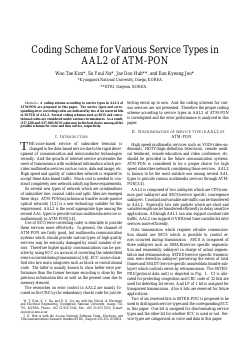
Coding Scheme for Various Service Types in AAL2 of ATM-PON
Woo Tae Kim, Su Youl Na, Jae Doo Huh, Eon Kyeong Joo
DOI: 10.14209/its.2002.190
Keywords:
Abstract
"A coding scheme according to service types in AAL2 of ATM-PON are proposed in this paper. The service types and corresponding error correcting codes are indicated by two of six reserved bits in SSTED of AAL2. Several coding schemes such as BCH and convolutional codes are considered under various circumstances. As a result, (127,120) and (127,106) BCH codes may be the best choice among all the possible schemes for voice and data service, respectively."Download

Design of Swap Interleaver without Edge Effect in CRC-turbo Concatenated Code
Byung Gil Lee, Sang Jae Bae, Eon Kyeong Joo
DOI: 10.14209/its.2002.195
Keywords:
Abstract
"Turbo code can achieve good error performance by iterative decoding, but more iterations result in additional computational complexity and delay. CRC-turbo concatenated code is known to be the most efficient method to reduce the number of iterations. However the performance may be degraded by the edge effect in this scheme like the conventional turbo code without CRC. A method to eliminate the edge effect is proposed by adopting D-parameter to the conventional swap interleaver in this paper. As results of simulations, the edge effect is shown to be successfully eliminated by using the new interleaver designed with D-parameter."Download

Space-Time Convolutional Codes Over GF(p) for the Quasi-Static, Flat Rayleigh Fading Channel
Mário de Noronha-Neto, Richard Demo Souza, Bartolomeu Ferreira Uchôa-Filho
DOI: 10.14209/its.2002.199
Keywords: Diversity fading channels multiple transmit antennas space-time convolutional codes wireless communications
Abstract
"In this paper, we consider a space-time coded system con- sisting of a rate R = 1/n linear convolutional encoder over GF(p), p a prime, followed by n mappers from GF(p) into a p-ary signal constellation, and by a transmitter with n transmit antennas. At each time, the n p-ary coded symbols are transmitted simultaneously from the n antennas. The convolutional codes are designed to provide the best error performance in the quasi-static, flat Rayleigh fading channel, according to the rank and the determinant criteria derived by Tarokh et. al. A spectral efficiency of logs (p) b/s/Hz is achieved. Simple conditions on the generator matrices of a rate R = 1/2 convolutional code are given so that maximum diversity advantage is guaranteed. The linear structure of these convolutional codes reduces significantly the computer search effort with regard to the determinant criterion. New space-time codes with two transmit antennas are presented for the 5-PSK and 7-PSK modulations, with spectral efficiencies 2.32 and 2.81 b/s/Hz, respectively."Download
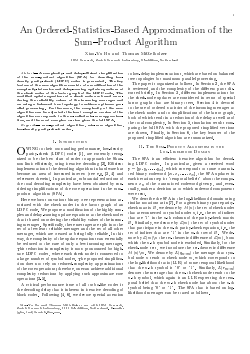
An Ordered-Statistics-Based Approximation of the Sum-Product Algorithm
Xiao-Yu Hu, Thomas Mittelholzer
DOI: 10.14209/its.2002.204
Keywords: sum—product algorithm min-sum algorithm low-density parity-check codes
Abstract
"A complexity- and delay-efficient simplification of the sum-product algorithm (SPA) for decoding low-density parity-check (LDPC) codes is presented. The key feature of the new algorithm consists of a modification of the complexity-intensive and delay-causing update equations at the check nodes of the factor graph of the LDPC code. The modified update equations at a check node are based on ordering the reliability values of the incoming messages and on using a balanced tree topology to achieve optimum parallel processing. Furthermore, the complexity of the new algorithm can be adjusted: the least complex version of the algorithm corresponds to the so-called min-sum approximation, and the most complex version gives the full SPA."Download
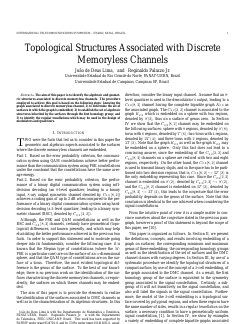
Topological structures associated with discrete memoryless channels
João de Deus Lima, Reginaldo Palazzo Jr.
DOI: 10.14209/its.2002.210
Keywords:
Abstract
"The aim of this paper is to identify the algebraic and geometric structures associated to discrete memoryless channels. The procedure employed to achieve this goal is based on the following steps: knowing the graph associated to discrete memoryless channel, 1) to determine the set of surfaces in which the graph is embedded; 2) to establish the set of algebraic structures inherited by the surfaces through the first homology group; and 3) to identify the regular tessellations which may be used in the design of modulators and quantizers."Download